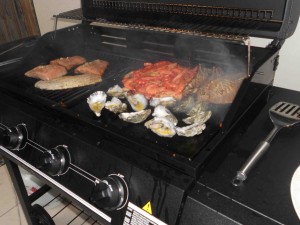In Seattle, King County health officials report there were 13 suspected cases of the saltwater bacteria Vibrio parahaemolyticus in the county during July, compared to an average of four reported in that month in recent years. Since the beginning of  August, an additional eight cases have been confirmed, while King County would typically only see six for the entire month.
August, an additional eight cases have been confirmed, while King County would typically only see six for the entire month.
Across Washington state, more than 40 residents have gotten sick with vibriosis.
“This is probably the tip of the iceberg,” said Dr. Jeff Duchin, chief of communicable disease for Seattle & King County Public Health. “For every case that is reported, an estimated 142 additional cases go unreported.”
People typically get vibriosis from eating raw or undercooked shellfish, particularly oysters. Residents who have pre-existing medical conditions or who take antacids regularly are at higher risk for illness from the vibrio infection.
Since June 2013, Connecticut has reported 19 confirmed cases of Vibrio parahaemolyticus infection, compared to an average of seven cases reported during the same time period in the past two years.
Shellfish should be cooked to an internal temperature of 145 degrees for at least 15 seconds, according to the U.S. Centers for Disease Control.
Not sure where that number came from, but I grill mine.
The Canadian Food Inspection Agency (CFIA) is warning the public not to serve or consume the raw shellfish products  described below because they may contain paralytic shellfish toxins that can cause illness if consumed.
described below because they may contain paralytic shellfish toxins that can cause illness if consumed.
These shellfish products were primarily distributed to wholesalers and institutional clients such as restaurants. However, the affected shellfish products may also have been sold in smaller quantities at some retail seafood counters. Consumers who are unsure whether they have the affected products are advised to check with their retailer or supplier.
These products have been distributed in Alberta and British Columbia. However, they may have been distributed in other provinces and territories.


.jpg) and 150,000 oysters prohibited from sale have been ordered to be destroyed.
and 150,000 oysters prohibited from sale have been ordered to be destroyed.
 authorities.
authorities.  foodborne illness found in certain raw shellfish.
foodborne illness found in certain raw shellfish.(1).jpg) We had another idea, which was to actually go out and talk to people, and we found out the manual pretty much stayed on the shelves.
We had another idea, which was to actually go out and talk to people, and we found out the manual pretty much stayed on the shelves. "Now, our staff training manual very clearly lays out a 48-hour return to work policy – you don’t come back to work until 48 hours after you feel better – and I don’t know many restaurants that do that.
"Now, our staff training manual very clearly lays out a 48-hour return to work policy – you don’t come back to work until 48 hours after you feel better – and I don’t know many restaurants that do that.
 Why didn’t I think of that?
Why didn’t I think of that?(1).jpg) * There was a large outbreak of food poisoning among diners at the Fat Duck Restaurant in January and February 2009, with more than 500 reporting illness – over 15% of those dining there during this period
* There was a large outbreak of food poisoning among diners at the Fat Duck Restaurant in January and February 2009, with more than 500 reporting illness – over 15% of those dining there during this period(1).jpg) * Delays in notification of illness may have affected the ability of the investigation to identify the exact reason for the norovirus contamination
* Delays in notification of illness may have affected the ability of the investigation to identify the exact reason for the norovirus contamination